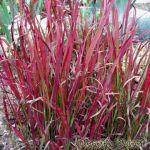| Common Name: |
Alang-alang |
| Other Names: |
Cogon, Woolly Grass, White Cottongrass, Lalang, Chigaya) |
| Botanical Name: |
Imperata cylindrica |
| Genus: |
Imperata |
| Family: |
Poaceae |
| Location: |
Warm, temperate and tropical Asia |
| Cultivation: |
Moist, well-drained, rich soil in sun or dappled shade. |
| Propagation: |
By division in spring. |
| Harvest: |
Rhizomes and flowers are collected as required and dried for decoctions. |
| Height: |
40cm (16in) |
| :Width |
30cm (12in)or more |
| Variations: |
Rubra syn. Red Baron
Japanese blood grass
Has red-flushed upper blades and deep red leaf tips. |
| Hardiness: |
Z7-8 |
| Parts Used: |
Rhizomes, flowers (bai mao gen) |
| Properties: |
A cooling, soothing, slightly sweet herb with tonic and diuretic effects. It is strongly hemostatic, suppresses bruising, and lowers fever. |
| Medicinal Uses: |
Internally for high fever with thirst, urinary tract infections, acute kidney infection, urine retention, hemorrhoids, nosebleeds, injuries involving bleeding and bruising, and for internal hemorrhage of all kinds. |
| Culinary Uses: |
Rhizomes are mixed with a purple form of sugar cane (Saccharum officinale), known as miá lau, to make a thirst-quenching drink. Immature flower heads are eaten as a potherb. Rhizomes yield edible manna, and a starch used in making beer. |
| Bibliography: |
Encylopedia of Herbs by Deni Brown Copyright ©: 1995, 2001 Dorling Kindersley Limited pp.242-243
|
